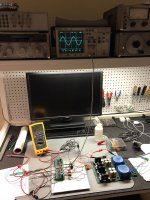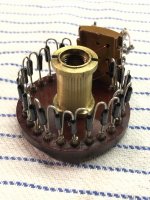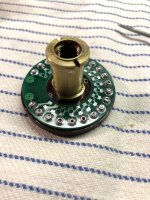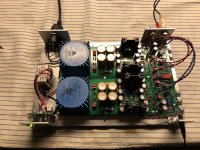Nice work!
I wonder, why you don't go smd for all the to92 small signal transistors? 😉
I tried to stick to the element base of the original author's version of Salas. SMD transistors are used as an alternative option, in case of unavailability of uPA68H( many fakes), BF256B (discontinued production). In the case of an operational amplifier, I think everything is clear. And I'm going to use 2SA970 transistors (I have the original Toshiba ones) or BC327. These transistors do not exist in SMD (SOT23 or otherwise).
You're right. For surface mount (SMD), there are equivalent models such as BC817 (NPN) and BC807 (PNP), but with a slightly lower peak collector current (Ic): 500 mA, probably due to the sot23 and sot223 housing type (SMD) used.
I am still trying to decipher...
Hello Alan,
To sum up:
1. The standard preamp+psu statistically performs neutrally. Builds are many for various systems and subjective feedback tends to that. You can't go wrong.
2. You can use various psu. No practical issue. Some come across more forceful in some frequencies. You can tweak their capacitor types. Tonal balance correct judgement takes long run auditions. Its a subtle and rather difficult matter to pinpoint or express.
3. BC560s as Q1 Q2 are better in slower sounding systems & speakers. Providing more NFB to the circuit. BC327-40 offer a more naturally relaxed sound in systems or headphones with above average analytical capability. IMHO, YMMV. They are basically lower impedance higher Cob transistors with less self noise.
4. Prefer 50k volume if on dry sounding systems & speakers. Invest in quality attenuation solutions. Alps Blue won't cut it in this pre. Will work, but "meh..."
Note:
I could have left this successful preamp alone but I always check new parts possibilities to subtly refine it. Not meaning to confuse. I also ask wider opinion on any potential change. As it was done lately in researching modern servo op-amp types. Even with cutting edge SMD chips it was difficult to surpass the original BOM U1 recommendation overall. If I settle on any alternative parts in any area you all know what and why. And it also goes to post #1.
Well, I took out the capacitors! No oscillation, still sounds fantastic. Better? No idea! 🙂
Did you measure slew rate before and after by any chance?
I did not. I built up a second board the other day and am waiting for power supply parts and replacement MOSFETs. I will see about making more measurements this time around.
-- Listening to Sarah Vaughan on DCG3 right now...
-Henry
-- Listening to Sarah Vaughan on DCG3 right now...
-Henry
off-topic question
Hi friends
I am building my electronics from top to bottom (started with the output stage, will end with a dac)...
Now, my question: What DAC that comes as "half-kit" (soldered PCB/modules) are recommended, audio-wise? (I was looking at soekris and twisted-pears, but I'm not sure about their respective SQ..., and what others are there?)
My electronics-knowledge is so-so or lower, and budget around €500, not very much either, and lower is welcome...
I ask in this forum because there are so many highly skilled + experienced geniuses here... 🙂
Hi friends
I am building my electronics from top to bottom (started with the output stage, will end with a dac)...
Now, my question: What DAC that comes as "half-kit" (soldered PCB/modules) are recommended, audio-wise? (I was looking at soekris and twisted-pears, but I'm not sure about their respective SQ..., and what others are there?)
My electronics-knowledge is so-so or lower, and budget around €500, not very much either, and lower is welcome...
I ask in this forum because there are so many highly skilled + experienced geniuses here... 🙂
The Khadas board is super-popular. The other one uses a very nice and soon-to-be-unavailable AKM DAC, but has I2S input so will require an additional board, for instance, to take USB input. Khadas is probably the safer and easier bet; uses Sabre DAC.
One of many... check out Allo.com too. They have nice DACs. I use their retired Katana DAC and never got regretted about my choice.
I will see about making more measurements this time around.
Slew rate and bandwidth should be lowest at half volume pot impedance position. Highest at full volume.
Better keep a reference, like 2V pk-pk square at a same high volume position or at max. For meaningful with and without your extra comp caps speed comparison.
If you also got some decent pc audio card or usb interface handy you may use it for a quick noise floor and THD all well confirmation. PC audio should take 1VRMS signal with not much self contribution yet. You check the pc audio residual with a self run first. Like in post #5446.
Right now my only signal source is a sinewave oscillator and I don't have an audio analyzer. I need to either get a sound card, or I'm considering getting a QuantAsylum QA402 when it comes out next month (but that will have to go to the appropriations committee for authorization). So detailed measurements will have to wait.
It looks like the parts I ordered last week might actually arrive tomorrow, so first thing is to get the second iteration up and running.
It looks like the parts I ordered last week might actually arrive tomorrow, so first thing is to get the second iteration up and running.
With the DCSTB sound is better on 18-0-18 trafos IMHO. Extra voltage drop across its Sziklai arranged pass transistors seems to work for them. But the PSU you built is different and I don't know how much it is affected or not.
I'm getting 22.5V under load from the raw supply. Jan specifies a minimum dropout of 5V for best performance: "The 5V recommendation is a good one." So I'm at the lower limit but it should be fine. I don't have nearly your experience and can't really say how these things work out subjectively. I try to make sensible design choices, and not to fret too much.
Last night I cannibalized my 100K through-hole Daven attenuators and installed some commercial PC boards I had made with the same layout as my original hand-etched prototypes. I think the second unit will end up as a line amp for the main system.
I've been fooling around in SPICE with a classic discrete op-amp HPA design. I have some NOS 2N5564s I want to try. It's a three-stage circuit with a follower output stage, basically a small D. Self blameless amplifier. I figure the only way to learn is to build different circuits and listen to them for myself.
I notice the DCG3 is very similar to Borbely's EB-602/201. I've been wondering if you ever listened to one of those compared to your circuit.
-Henry
Last night I cannibalized my 100K through-hole Daven attenuators and installed some commercial PC boards I had made with the same layout as my original hand-etched prototypes. I think the second unit will end up as a line amp for the main system.
I've been fooling around in SPICE with a classic discrete op-amp HPA design. I have some NOS 2N5564s I want to try. It's a three-stage circuit with a follower output stage, basically a small D. Self blameless amplifier. I figure the only way to learn is to build different circuits and listen to them for myself.
I notice the DCG3 is very similar to Borbely's EB-602/201. I've been wondering if you ever listened to one of those compared to your circuit.
-Henry
Attachments
Never listened to or even seen one. I learned it existed after a member mentioned it a couple of years later I designed and introduced the DCG3.
I got unit #2 running last week and built up a little breadboard over the weekend. I was getting a lot of hum and noise, and clicks when I plugged in the phones, but only with the sensitive PX-100s, not the AKGs. It was also really sensitive to hum pickup from the cables and power cord, and didn't like running from the Topping/RPi with wall wart power, though it was quiet with my AMB Gamma2 running off of battery power via my MacBook Pro. Touching the chassis would greatly modulate the noise level, as would putting my fingers on the JFETs.
After driving myself nuts fooling around with grounding and fretting about common-mode noise, I finally went looking for instability and found a low-level oscillation in the 10MHz range, like with the prototype. I had routed the signal wires under the board which, in retrospect, isn't too bright. So I took everything apart and moved the wires above-board. I also moved the connector block away from the output stage. I was sure that would fix it, but the oscillation actually got worse. So I went and installed my 22pF compensation cap mod as suggested by Kevin Kennedy and that killed the oscillation straight away. Closed-loop bandwidth stayed the same, about 2.5MHz, with or without compensation. Hum was still noticeable, but consistent and not affected by touching the chassis anymore. I moved the connectors back to the edge of the chassis (away from the rectifiers) which helped, and then I wrapped the wires in aluminum foil which I connected to ground, and that dropped the hum down close to the residual hiss level. This is with a wide-open input and no attenuator.
DC offset is in the range of 1mV or less. I think the click when I plugged in the phones was caused by the servo loop getting a jolt when the oscillation started. Again, there were no issues with the higher-impedance AKG phones. Listening with the AKGs, I heard no difference with compensation.
This is all a little peculiar because my prototype oscillated with no load, but settled down when I plugged in the PX-100s.
I took the amplifier over to Kevin's house last night and left it with him. He just sent me an email with his impressions. In a nutshell, he's really impressed. I hope he'll drop by in this thread and give a report.
After driving myself nuts fooling around with grounding and fretting about common-mode noise, I finally went looking for instability and found a low-level oscillation in the 10MHz range, like with the prototype. I had routed the signal wires under the board which, in retrospect, isn't too bright. So I took everything apart and moved the wires above-board. I also moved the connector block away from the output stage. I was sure that would fix it, but the oscillation actually got worse. So I went and installed my 22pF compensation cap mod as suggested by Kevin Kennedy and that killed the oscillation straight away. Closed-loop bandwidth stayed the same, about 2.5MHz, with or without compensation. Hum was still noticeable, but consistent and not affected by touching the chassis anymore. I moved the connectors back to the edge of the chassis (away from the rectifiers) which helped, and then I wrapped the wires in aluminum foil which I connected to ground, and that dropped the hum down close to the residual hiss level. This is with a wide-open input and no attenuator.
DC offset is in the range of 1mV or less. I think the click when I plugged in the phones was caused by the servo loop getting a jolt when the oscillation started. Again, there were no issues with the higher-impedance AKG phones. Listening with the AKGs, I heard no difference with compensation.
This is all a little peculiar because my prototype oscillated with no load, but settled down when I plugged in the PX-100s.
I took the amplifier over to Kevin's house last night and left it with him. He just sent me an email with his impressions. In a nutshell, he's really impressed. I hope he'll drop by in this thread and give a report.
Attachments
Yup, I really like it. It was sort of an eye opener as I had thought the headphone amplifier in my Topping DX3pro was quite good - it's not. LOL The DCG3 demonstrated that in just a few minutes with my Oppo Planar 3 headphones.
It's extremely quiet, has much better performance in the LF, the bass performance with the dac was a bit anemic, this sounds more extended and better controlled.
There is more low level detail and a clarity without brightness - the dac headphone amp is both brighter/lighter sounding and considerably less resolving. I was surprised by what I had not heard before in about 90 minutes of listening.
It's more dynamic.
I'll be using this in my wind down time in late evening. I won't be tinkering with it or attempting to improve it. I won't be measuring it. It's well designed and suited to its purpose so I am just going to enjoy it.
Subjectively this is the best sounding headphone amp I have heard. I've designed a few over the decades and listened to a number of them in Montreal.
It's extremely quiet, has much better performance in the LF, the bass performance with the dac was a bit anemic, this sounds more extended and better controlled.
There is more low level detail and a clarity without brightness - the dac headphone amp is both brighter/lighter sounding and considerably less resolving. I was surprised by what I had not heard before in about 90 minutes of listening.
It's more dynamic.
I'll be using this in my wind down time in late evening. I won't be tinkering with it or attempting to improve it. I won't be measuring it. It's well designed and suited to its purpose so I am just going to enjoy it.
Subjectively this is the best sounding headphone amp I have heard. I've designed a few over the decades and listened to a number of them in Montreal.
Hi Kevin, nice that you like it. Has similar behavior in a line preamp's role too. Henry's variations are rebellious but he has gathered expertise on how to tame them. You probably decided wisely not to tinker any further. Don't fix what's not broken they say.
- Home
- Source & Line
- Analog Line Level
- Salas DCG3 preamp (line & headphone)





